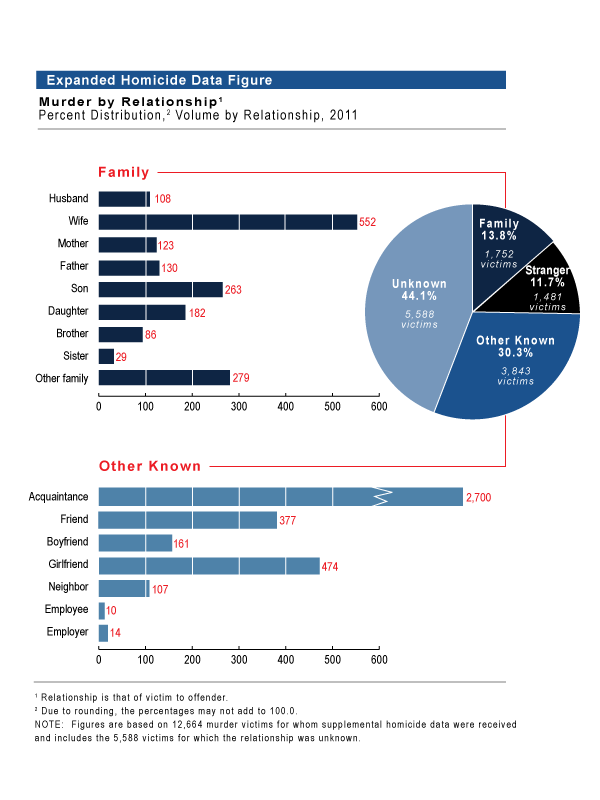
Expanded Homicide Data
Data collection
The Uniform Crime Reporting (UCR) Program of the FBI collects supplementary homicide data that provides information regarding the age, sex, and race of the murder victim and offender; the type of weapon used; the relationship of the victim to the offender; and the circumstance surrounding the incident. Data gleaned from these supplemental data are provided in this section.
This section also includes information about justifiable homicide—certain willful killings that must be reported as justifiable or excusable. In the UCR Program, justifiable homicide is defined as and limited to:
- The killing of a felon by a peace officer in the line of duty.
- The killing of a felon, during the commission of a felony, by a private citizen.
Because these killings are determined through law enforcement investigation to be justifiable, they are tabulated separately from murder and nonnegligent manslaughter. Justifiable homicide information can be found in Expanded Homicide Data Table 14, “Justifiable Homicide, by Weapon, Law Enforcement, 2007–2011” and Expanded Homicide Data Table 15, “Justifiable Homicide, by Weapon, Private Citizen, 2007–2011.”
Overview
- Of the 12,664 murder victims in 2011 for which supplemental data were received, most (77.6 percent) were male. (Based on Expanded Homicide Data Table 1.)
- Concerning murder victims for whom race was known, 50.0 percent were black, 46.0 percent were white, and 2.6 percent were of other races. Race was unknown for 175 victims. (Based on Expanded Homicide Data Table 2.)
- Single victim/single offender situations accounted for 48.4 percent of all murders for which the UCR Program received supplemental data. (See Expanded Homicide Data Table 4.)
- Of the offenders for whom gender was known, 89.3 percent were males. (Based on Expanded Homicide Data Table 3.)
- Of the offenders for whom race was known, 52.4 percent were black, 45.2 percent were white, and 2.4 percent were of other races. The race was unknown for 4,077 offenders. (Based on Expanded Homicide Data Table 3.)
- Of the homicides for which the FBI received weapons data, most (67.8 percent) involved the use of firearms. Handguns comprised 72.5 percent of the firearms used in murder and nonnegligent manslaughter incidents in 2011. (Based on Expanded Homicide Data Table 8.)
- In 2011, in incidents of murder for which the relationships of murder victims and offenders were known, 54.3 percent were killed by someone they knew (acquaintance, neighbor, friend, boyfriend, etc.); 24.8 percent of victims were slain by family members. The relationship of murder victims and offenders was unknown in 44.1 percent of murder and nonnegligent manslaughter incidents in 2011. (Based on Expanded Homicide Data Table 10.)
- Of the female murder victims for whom the relationships to their offenders were known, 36.5 percent were murdered by their husbands or boyfriends. (Based on Expanded Homicide Data Tables 2 and 10.)
- Of the murders for which the circumstance surrounding the murder was known,
42.9 percent of victims were murdered during arguments (including romantic triangles) in 2011. Felony circumstances (rape, robbery, burglary, etc.) accounted for 23.1 percent of murders. Circumstances were unknown for 38.0 percent of reported homicides. (Based on Expanded Homicide Data Table 11.) - Law enforcement reported 653 justifiable homicides in 2011. Of those, law enforcement officers justifiably killed 393 felons, and private citizens justifiably killed 260 people during the commission of a crime. (See Expanded Homicide Data Tables 14 and 15.)

- The following tables were compiled using information from the Supplementary Homicide Data:
- Expanded Homicide Data Table 1—“Murder Victims by Race and Sex, 2011”
- Expanded Homicide Data Table 2—“Murder Victims by Age, Sex, and Race, 2011”
- Expanded Homicide Data Table 3—“Murder Offenders by Age, Sex, and Race, 2011”
- Expanded Homicide Data Table 4—“Murder, by Victim/Offender Situations, 2011”
- Expanded Homicide Data Table 5—“Murder, Age of Victim by Age of Offender, 2011 [Single victim/single offender]”
- Expanded Homicide Data Table 6—“Murder, Race and Sex of Victim by Race and Sex of Offender, 2011 [Single victim/single offender]”
- Expanded Homicide Data Table 7—“Murder, Types of Weapons Used, Percent Distribution by Region, 2011”
- Expanded Homicide Data Table 8—“Murder Victims by Weapon, 2007–2011”
- Expanded Homicide Data Table 9—“Murder Victims by Age, by Weapon, 2011”
- Expanded Homicide Data Table 10—“Murder Circumstances by Relationship, 2011”
- Expanded Homicide Data Table 11—“Murder Circumstances by Weapon, 2011”
- Expanded Homicide Data Table 12—“Murder Circumstances, 2007–2011”
- Expanded Homicide Data Table 13—“Murder Circumstances by Sex of Victim, 2011”
- Expanded Homicide Data Table 14—“Justifiable Homicide by Weapon, Law Enforcement, 2007–2011”
- Expanded Homicide Data Table 15—“Justifiable Homicide by Weapon, Private Citizen, 2007–2011”
- Table 20—“Murder, by State, Types of Weapons, 2011”

